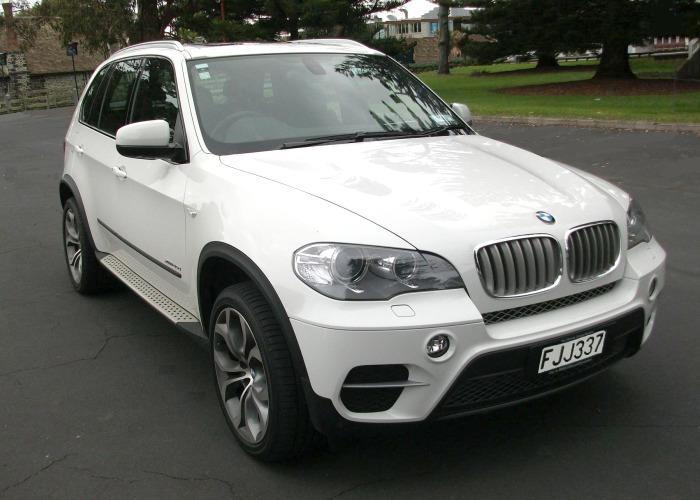
Car reviews
Read our expert car reviews - where we give insight into the latest vehicles to hit our roads.
09 February 2011
Power trains are the major upgrade for the otherwise mildly revamped 2010 BMW X5. BMW is now offering just three powerplants to X5 buyers, two diesel and one petrol, all mated to an eight speed automatic transmission.

Large SUV’s with high output engines and blistering performance have copped a fair amount of criticism in these times of ecological awareness for their unfavourable environmental impact .
But it doesn’t have to be that way. With BMW having waved the “EfficientDynamics” wand over the X5 being proof that you can have your cake and eat it, and the X5 xDrive40d Sport we drove recently hammering home the point.
Capable of accelerating from 0 – 100km/h in 6.6 seconds, the diesel powered X5 xDrive40d produces 225Kw of power and 600Nm of torque.
Not so long ago, these figures would have done a gas guzzling performance car proud, but with a combined fuel consumption of 7.5L/100km and a kerb weight of over 2.1 tonne, it’s all the more impressive.
BMW uses the term ‘Life Cycle Impulse’ (LCI) to describe their facelift models, and for the latest incarnation of the X5 it’s a fitting description, as visually there’s very little to shout about. Revised bumpers, LED “Corona ring” running lights up front and revised tail lights are about the only visible signs of change externally.
Although the E70 X5 has been around since 2006, it continues to make up around half of BMW’s sales volume locally. In the 10 years since BMW launched the original E53 X5, over one million units have been sold globally, and here in New Zealand, the X5 has been BMW’s biggest seller in every year but one.
Power trains are the major upgrade for the otherwise mildly revamped X5.
BMW is now offering just three powerplants to X5 buyers, two diesel and one petrol, all mated to an eight speed automatic transmission.
The new eight speed ‘box shifts almost seamlessly, and makes a big contribution to fuel saving. With a wide spread range of ratios, the engine is always operating in its optimum rev band, and around town the engine spends most of its time just a little above idle.
The range starts with the 3.0 litre diesel fuelled 180kW xDrive30d SE priced at $125,000, stepping up to the mid-range xDrive40d SE at $142,000 and the only petrol powered version, the xDrive50i SE topping the range at $164,000.
The 4.4 litre V8 powered xDrive50i SE produces 300kW and 600Nm and is capable of reaching 100km/h from standstill in 5.5 seconds. But shaving that 1.1 seconds off the xDrive40d’s run to 100km/h almost doubles the fuel consumption, with the V8 petrol engine consuming 12.5L/100km.
TwinPower: One name fits all.
Both the xDrive40d and the xDrive50i force feed their respective fuels with TwinPower. BMW uses the term to describe either twin-turbo or twin-scroll single turbo, telling us that a one-term-fits-all description simplifies things.
All models get run-flat tyres, now capable of travelling up to 1,000km with as little as 3psi pressure. Standard for the xDrive30d are 18 inch star spoke alloys, 19 inch Y spoke alloys are fitted on the xDrive40d, and the xDrive50i gets 20 inch Y spokes
An 18 inch spare wheel is supplied, but not if you tick the $4,600 option 4UB – third row seating. Then you have to rely on your run-flats to get you home.
Driver assistance systems; some standard, some options, include Active Cruise Control with Stop and Go function, Head Up Display, Lane Departure Warning, Side View Cameras and a Reversing Camera with Top View to give all-round visibility when reversing in tight spaces.
BMW has added Sports Package as standard equipment on the xDrive40d up, which includes sports leather steering wheel, sport suspension, sport seats, high-gloss shadow-line trim and anthracite headliner.
Our test vehicle was fitted with numerous options including panorama glass roof ($4,330), Xenon headlights ($2,250), comfort front seats ($2,900), adaptive headlights ($1,190), aluminium running boards ($840) and a raft of additional equipment, taking the retail sticker from $142,000 out to $164,280.
Even though the X5’s styling is starting to show its age and there are at least a couple of competitors whose cabin ambience offer more sense of occasion, dynamically it remains the benchmark, and for performance versus fuel efficiency it still offers great bang for your buck.